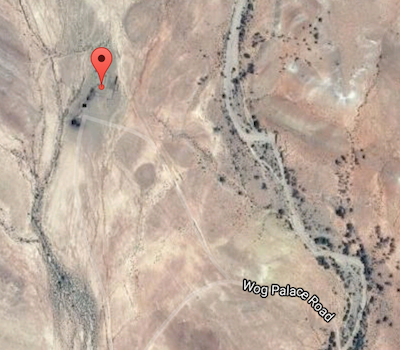Speaking of boring places, the phenomenon didn’t confine itself exclusively to Oregon. Sure, the largest Boring town existed just outside of Portland. However, because Boring was also a surname, it spread to other locations as one might expect. Residents tended to have the same sense of humor about living in Boring places everywhere. The same bad puns, the same entertainingly-named public institutions and businesses, the same frequently-photographed road signs formed a common bond. The repetition became, well, boring. Fortunately the stories found just below the surface offered additional entertainment.
Boring, Maryland

What Maryland’s Boring lacked in population it gained in recognition through the U.S. Postal Service (map). Boring, Maryland 21020 didn’t have the same cachet as Beverly Hills 90210, although it still existed as a physical place. Other than that, the hamlet consisted primarily of a few homes along the intersection of Old Hanover and Pleasant Grove Roads. The Boring Post Office along with a Boring Fire Hall and a Boring Methodist Church also offered popular photo opportunities for outsiders passing through.
The Washington Post featured a Boring article back in 1984.
“The origin of its name is somewhat less boring than the name itself. The town originally was called Fairview, but according to folks hereabouts, when the post office was established in 1880, postal authorities ordered the town renamed, apparently to avoid confusion with all the other Fairviews in the United States. ‘So it was named by the townspeople after the first postmaster here, David J. Boring, in 1880,’ explained Cullison, himself a postmaster of Boring from 1950 to 1976.”
It served as yet another example of a town changing its name because of postal delivery, a common condition in the late 19th Century. We’ve seen that happen many times on Twelve Mile Circle although the results were not usually so Boring.
Boring, Tennessee
I found very little information about Boring, Tennessee. It registered a level of boring so extreme that nobody even bothered to publicize it. Actually, I shouldn’t say that. I’m sure people who lived there liked it just fine. It didn’t even make the list of Top 10 most boring places in Tennessee. That honor went to Forest Hills near Nashville. I don’t know why. Maybe Boring’s placement at the end of a runway at Tri-Cities Airport made the difference. Jet traffic wouldn’t be boring; more annoying than anything, really.
The author of Tennessee Place-names pretty much phoned it in when explaining Boring.
“Boring Sullivan County. The only individual with the Boring surname who could be placed in this locality was Elizabeth Boring, in 1870. She was 46 years of age at the time. Possibly she, or her family, gave this place its name.”
Way to go out on a limb.
King Boring Park and Field

Honestly I didn’t expect to find anything about King Boring Park. I spotted the name and fell in love with it. What could be better than King Boring? Truly, the King of Boring (let’s pause and savor that for a moment).
A Yelp page, yes a Yelp page of all things, offered an explanation. The great-grandson of King Boring — so King Boring was an actual person — provided a fairly complete biography. I assumed a level of accuracy. Who would make up something about an obscure ball field (map) in Dearborn, Michigan? It could be fake. Who knows? Let’s assume it’s real and move along.
Apparently Mr. Boring earned the nickname King as a child after he beat-up a bully. Later he legally changed his actual name to King Boring. He owned a basketball team called the Detroit Gems and later sold it. The new owners moved the team to Minneapolis and changed the name to the Lakers. That team eventually became the Los Angeles Lakers. Right, those Lakers. Boring also coached a Single-A baseball team in Dearborn and participated in lots of other local sports-related stuff. He died in 1996.
I found some corroborating evidence. The Gems played only a single season, posting a 4-40 record before King Boring and his partner sold the team in 1947. Oof! He later lamented that he should have retained a percentage instead of selling it outright.
UPDATE: I wrote an article about King Boring.
Boring Homestead, South Australia

Why should the United States get all the boring places? I turned to the Gazetteer of Australian Place Names and found the Boring Homestead in South Australia (map). It sat about 550 kilometres (340 miles) due north of Adelaide. I wouldn’t expect to find any additional information about a single homestead, and I didn’t. However, I noticed the name of the road — a dirt track really — that led to the structure. Google called it Wog Palace Road, which seemed really odd. It seemed even stranger when I checked its etymology. I found an enlightening entry in Global English Slang: Methodologies and Perspectives.
“In the 1950’s and 1960’s in Australia wog came to be used to describe migrants of southern European origin, especially those from Italy or Greece. Later, the usage expanded to include migrants of Middle Eastern origin…a wog mansion or wog palace is a large and vulgar house, often using southern European architectural features such as elaborate columns.”
The word wog didn’t mean anything to me. However, and apparently, it could be considered offensive in Australia and perhaps even more so in the UK. For that, I apologize in advance, especially to 12MC’s Australian and UK audience. I didn’t mean to be insensitive. A wog palace would be like a McMansion in the United States with an added twist of racial spite thrown in for good measure.
I took an actual screen print of the homestead and street name which I’ve reproduced above. That’s because I expected it will be changed or removed someday. I wondered if that was really its name or if a vandal placed it there as digital graffiti, expecting nobody to find it.

Leave a Reply